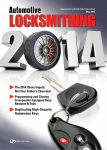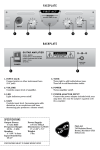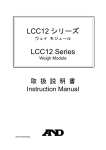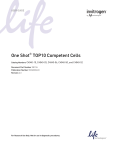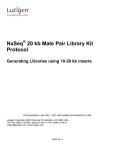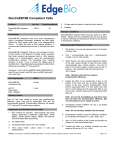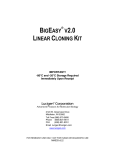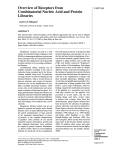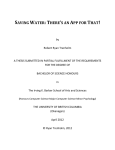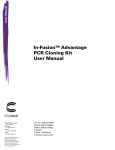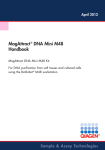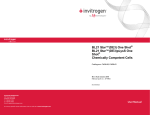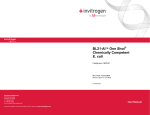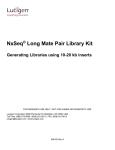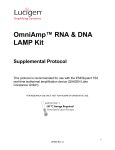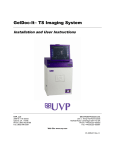Download BLUNT CLONING KITS
Transcript
BLUNT CLONING KITS IMPORTANT! -80°C and -20°C Storage Required Immediately Upon Receipt Lucigen Corporation ® Advanced Products for Molecular Biology 2120 W. Greenview Drive Middleton, WI 53562 Toll Free: (888) 575-9695 Tel: (608) 831-9011 FAX: (608) 831-9012 Email: [email protected] Internet: www.lucigen.com FOR RESEARCH USE ONLY. NOT FOR HUMAN OR DIAGNOSTIC USE MA004 v11.3 CLONESMART® Blunt Cloning Kits Technical Support Lucigen is dedicated to the success and satisfaction of our customers. Our products are tested to assure they perform as specified when used according to our recommendations. It is imperative that the reagents supplied by the user, especially the DNA targets to be cloned, are of the highest quality. Please follow the manual carefully and contact our technical service representatives if additional information is necessary. We encourage you to contact us with your comments regarding the performance of our products in your applications. Thank you. Notice of Limited Label License, Copyright, Patents, Warranties, Disclaimers and Trademarks Copyright© 2001-2004 by Lucigen Corp. All rights reserved. UltraClone, CloneDirect, pcrSMART, pEZ, pEZSeq, cSMART, PCR-SMART, and Replicator are trademarks of Lucigen Corp. Lucigen, CloneSmart, ClonePlex, DNATerminator, E. cloni, PCRTerminator and pSMART, CopyRight, and NanoClone are registered trademarks of Lucigen Corp. HydroShear® and GeneMachines® are registered trademarks of GeneMachines Corporation (San Carlos, CA). Vent is a trademark of New England Biolabs, Inc. DH10B and DH5 are trademarks of Invitrogen Corp. Lucigen’s products are sold for research use only and are not to be used in humans or for medical diagnostics. Lucigen’s liability with respect to any CloneSmart product is limited to the replacement of the product. No other warranties of any kind, expressed or implied, including without limitation, any implied fitness for any particular use, are provided by Lucigen. Lucigen is not liable for any direct, indirect, incidental or consequential damages arising out of or in connection with the use or inability to use any of its CloneSmart products. Limited Label License This product is the subject of U.S. Patent #6,709,861 and pending patent applications owned by Lucigen Corporation. The consideration paid for this product grants a Limited License to use the product pursuant to the terms set forth in this Limited Label License. Academic, Not-for-Profit and For-Profit institutions acquire certain limited nontransferable rights with the purchase of this product (see below). The purchase price of this product includes limited, nontransferable rights to use only the purchased amount of the product to perform CloneSmart Blunt Cloning Technology and only as described in CloneSmart Blunt Cloning Kit Instruction Manual. This limited license specifically excludes manufacture of the pSMART vector or derivatives thereof. Lucigen Corporation reserves all other rights; in particular, the purchaser of this product may not transfer or otherwise sell this product or its components or derivatives to a third party, and no rights are conveyed to the purchaser to use the product or its components or derivatives for commercial purposes. “Commercial purposes” includes any activity for which a party receives consideration and may include, but is not limited to, (1) use of the product or its components or derivatives in manufacturing, (2) use of the product or its components or derivatives for diagnostic purposes, (3) transfer or sale of vectors made with the product or components or derivatives of the product, (4) use of this product or materials made therefrom to provide a service, information, or data (e.g., DNA sequence) to a third party in return for a fee or other consideration, or (5) resale of the product or its components or derivatives, whether or not such product or its components or derivatives are resold for use in research. Academic, Not-for-Profit, and For-Profit institutions must obtain a separate license from Lucigen Corporation to use this product for any purpose other than those permitted above. It is the sole responsibility of the buyer to ensure that use of the product does not infringe that patent rights of third parties. If the purchaser is not willing to accept these use limitations, Lucigen Corporation is willing to accept return of the product for a full refund. For information on obtaining a license, contact Lucigen Corporation, 2120 W. Greenview Dr., Middleton, WI 53562. Email: [email protected]. Phone: 608-831-9011. Fax 608-831-9012. Lucigen® Corporation (888) 575-9695 2 MA004 v11.3 www.lucigen.com CLONESMART® Blunt Cloning Kits Table of Contents CloneSmart Kit Designations .......................................................................................... 4 Components & Storage Conditions ................................................................................. 4 CloneSmart Blunt Cloning Kit Description ....................................................................... 5 pSMART® Vectors ........................................................................................................... 6 E. cloni® Competent Cells ............................................................................................... 7 End Repair of Sheared DNA ........................................................................................... 7 Purification and Size Fractionation of DNA ..................................................................... 8 Sensitivity of DNA to Short Wavelength UV Light ........................................................... 8 Materials and Equipment Needed ................................................................................... 8 Detailed Protocol ............................................................................................................. 9 Preparation and Purification of Insert DNA...................................................................... 9 Ligation to the pSMART Vector....................................................................................... 9 Preparation for Transformation ..................................................................................... 10 Transformation .............................................................................................................. 10 Electroporation of E. cloni Electrocompetent Cells..................................................... 10 Heat Shock Transformation E. cloni Chemically Competent Cells ............................. 11 No Screening Required ................................................................................................. 13 DNA Isolation & Sequencing ......................................................................................... 14 References.................................................................................................................... 14 Appendix A: Media Recipes .......................................................................................... 15 Appendix B: Application Guide...................................................................................... 15 Appendix C: Abbreviated Protocol ................................................................................ 16 Appendix D: Vector Map, Cloning Site, and Sequencing Primers ................................. 17 Appendix E: Troubleshooting Guide.............................................................................. 18 Lucigen® Corporation (888) 575-9695 3 MA004 v11.3 www.lucigen.com CLONESMART® Blunt Cloning Kits CloneSmart Kit Designations Several versions of the CloneSmart Blunt Cloning Kit are available. The Kits differ in number of reactions, version of pSMART® vector (high or low copy; kanamycin or ampicillin resistance), and E. cloni ® 10G Cells (electrocompetent; chemically competent; or no cells). Cells in the DUO format contain 2 transformations per vial; the SOLO format is 1 transformation per vial. Please refer to Appendix B: Application Guide for more information and recommended uses of the Kits. Catalog numbers of vector and cell combinations Vector 10G ELITE Rxns Electrocompetent Cells DUO pSMART-HCKan (High Copy) pSMART-LCKan (Low Copy) pSMART-HCAmp (High Copy) 10G Chemically Competent Cells No Cells DUO SOLO DUO SOLO 40717-1 40719-1 40728-1 40730-1 --- 10 40706-1 40708-1 20 40706-2 40708-2 40717-2 40719-2 40728-2 40730-2 40704-2 40 --- --- --- --- --- --- 40704-4 10 40832-1 40834-1 40843-1 40845-1 40854-1 40856-1 --- 20 40832-2 40834-2 40843-2 40845-2 40854-2 40856-2 40821-2 40 --- --- --- --- --- --- 40821-4 10 40052-1 40054-1 40063-1 40065-1 40074-1 40076-1 --- 20 40052-2 40054-2 40063-2 40065-2 40074-2 40076-2 40041-2 --- --- --- --- --- 40041-4 40 pSMART-LCAmp (Low Copy) SOLO 10G SUPREME Electrocompetent Cells --- 10 40311-1 40313-1 40322-1 40324-1 40333-1 40335-1 --- 20 40311-2 40313-2 40322-2 40324-2 40333-2 40335-2 40300-2 40 --- --- --- --- --- --- 40300-4 Components & Storage Conditions The Ligation Components of the CloneSmart Kits are shipped in Container 1, which should be stored at -20oC. If E. cloni Cells are ordered with the Kit, they are shipped in Container 2, which must be stored at -80oC. Additional CloneSmart Ligation Components and E. cloni Competent Cells may be purchased separately. Store at -20°C Container 1: CloneSmart Ligation Components 4X CloneSmart Vector Premix Includes Buffer, ATP, and one type of ligation-ready Vector: pSMART-HCKan Premix or pSMART-LCKan Premix or pSMART-HCAmp Premix or pSMART-LCAmp Premix CloneSmart DNA Ligase (2 U/μl) Positive Control Insert DNA (500 ng/μl lambda HincII) CloneSmart Sequencing Primers (200 reactions each) SL1 Primer (3.2 pmol/μl) SR2 Primer (3.2 pmol/μl) 10 Reactions 25 μl Lucigen® Corporation (888) 575-9695 20 Reactions 40 Reactions 1 x 50 μl 2 x 50 μl 12 μl 5 μl 24 μl 5 μl 2 x 24 μl 2 x 5 μl 200 μl 200 μl 200 μl 200 μl 2 x 200 μl 2 x 200 μl 4 MA004 v11.3 www.lucigen.com CLONESMART® Blunt Cloning Kits Store at -80°C Container 2: E. cloni ® Competent Cells STRAIN Efficiency Transformations (cfu/μg pUC19) Catalog # E. cloni Electrocompetent Cells E. cloni 10G SUPREME DUOs > 4 x 1010 E. cloni 10G SUPREME SOLOs E. cloni 10G ELITE DUOs > 2 x 1010 E. cloni 10G ELITE SOLOs 12 ( 6 x 50 µl) 24 ( 12 x 50 µl) 60080-1 60080-2 12 ( 12 x 25 µl) 24 ( 24 x 25 µl) 60081-1 60081-2 12 ( 6 x 50 µl) 24 ( 12 x 50 µl) 60052-1 60052-2 12 ( 12 x 25 µl) 24 ( 24 x 25 µl) 60051-1 60051-2 E. cloni Chemically Competent Cells E. cloni 10G Chemically Competent DUOs > 1 x 108 E. cloni 10G Chemically Competent SOLOs 12 ( 6 x 80 µl) 24 ( 12 x 80 µl) 60107-1 60107-2 12 ( 12 x 40 µl) 24 ( 24 x 40 µl) 60106-1 60106-2 Medium and Controls Recovery Medium Store at -20 to -80°C 12 ( 1 x 12 ml) 24 ( 2 x 12 ml) 96 ( 8 x 12 ml) ------80026-1 *Supercoiled pUC19 DNA (1 ng/μl) Store at -20 to -80°C 10 ( 1 x 10 µl) ---- YT Agar (powder) ---- Additional competent cells are available separately from Lucigen (please see our web site: www. lucigen.com). Lucigen® Corporation (888) 575-9695 5 MA004 v11.3 www.lucigen.com CLONESMART® Blunt Cloning Kits CloneSmart Blunt Cloning Kit Description Lucigen’s CloneSmart transcription-free cloning technology (U.S. Pat. 6, 709, 861) is designed to eliminate cloning bias and maximize cloning efficiency. The pSMART® vectors are supplied predigested, with blunt dephosphorylated ends, and are qualified to produce 99.5% recombinant clones in typical experiments. The ultra-low background of empty vector (less than 0.5%) eliminates the need to screen for recombinants and enables library construction from nanogram amounts of DNA. Because no screening is required, CloneSmart technology eliminates the need for XGAL/IPTG and removes the uncertainty of false negatives (light blue pUC colonies) and false positives (white colonies that lack inserts). In contrast, conventional vectors utilizing the blue/white screen can generate a dense background of blue colonies and many ambiguous “light blue” colonies, both of which may contain inserts but are often discarded. The DNA contained in such clones is lost and consequently thought to be “unclonable”, leading to gaps in sequence assemblies. Conventional ampicillin-resistant plasmids are often surrounded by non-transformed “satellite” colonies, which complicate colony picking and contaminate cultures. Growth of satellite colonies is completely eliminated with the kanamycin-resistant pSMART vectors. Furthermore, the ampicillin-resistant versions of pSMART vectors have been designed to reduce the growth of satellite colonies. The kits are ideal for constructing shotgun libraries, for general purpose cloning, or for cloning blunt PCR products, especially when amounts of target DNA are limited. The CloneSmart Blunt Cloning Kits are convenient to use, containing pre-cut, dephosphorylated pSMART cloning vector premixed with buffer and ATP, high-efficiency E. cloni ® Electrocompetent or Chemically Competent Cells, as well as ligase, sequencing primers, and DNA controls. Kits without cells are also available. Figure 1. Schematic diagram of the pSMART vectors. Ori, origin of replication; Amp, ampicillin resistance gene; Kan, Kanamycin resistance gene; ROP, Repressor of primer (lowers plasmid copy number). Approximate positions of sequencing primers and transcription terminators (T) are indicated. Lucigen® Corporation (888) 575-9695 6 MA004 v11.3 www.lucigen.com CLONESMART® Blunt Cloning Kits pSMART® Vectors The pSMART vectors contain high- or low-copy replication origins and kanamycin or ampicillin resistance (Figure 1). The unique design of these vectors eliminates transcription both into and out of the insert DNA, reducing the cloning bias commonly found with standard plasmids. In conventional plasmids, strong promoters are used to transcribe an indicator gene such as lacZα or a negative selection gene such as ccdB. DNA cloned into these vectors can be lost due to plasmid instability caused by transcription of toxic coding sequences, strong secondary structure, or other deleterious features. The pSMART vectors do not use a promoter or an indicator gene, so transcription across the insert is avoided. Conventional plasmids can also be lost due to fortuitous transcription from inserts containing E. coli-like promoters, which can cause instability by transcribing into essential regions of the vector. In pSMART vectors, strong transcription terminators flank the cloning site to block this transcription (Figure 1), eliminating another cause of lost clones. All pSMART vectors are supplied pre-cut with blunt, dephosphorylated ends (Figure 1). The copy number of the pSMART-HCKan and -HCAmp vectors is similar to that of pUC plasmids (~300 copies/cell) and that of the pSMART-LCKan and -LCAmp vectors is similar to pBR322 (~20/cell). The only difference between the high copy and low copy plasmids is the presence of the ROP gene in the low copy versions, which inhibits plasmid replication. Blunt-ended, 5’-phosphorylated insert DNA is ligated to the pSMART vector, transformed into competent cells, and spread on plates containing kanamycin or ampicillin. pSMART transformants do NOT require additional screening against colonies containing empty vector, as they typically are not present at detectable levels. The GenBank accession numbers for the vectors are as follows: pSMART-HC, AF399742; pSMART-LC, AY090111; pSMART-HCKan, AF532107; and pSMART-LCKan, AF532106. E. cloni® Competent Cells For maximum cloning efficiency, use of Lucigen’s E. cloni 10G Competent Cells is strongly recommended. E. cloni 10G Competent Cells are E. coli strains optimized for high efficiency transformation. They are ideal for cloning and propagation of BAC, cosmid, or plasmid clones. They give high yield and high quality plasmid DNA due to the recA1 and endA1 mutations. They are also phage T1-resistant (tonA mutation). E. cloni 10G strains contain the inactive mcr and mrr mutations, allowing methylated genomic DNA that has been isolated directly from mammalian or plant cells to be cloned without deletions or rearrangements. The rpsL mutation confers resistance to streptomycin. Lucigen’s CloneSmart Blunt Cloning Kits are available with the following preparations of E. cloni Competent Cells: E. cloni 10G SUPREME Electrocompetent Cells deliver > 4 x 1010 cfu/μg. Ideal for the most demanding applications that require the greatest number of transformants, such as construction of large, high complexity libraries or cloning difficult targets. E. cloni 10G ELITE Electrocompetent Cells deliver > 2 x 1010 cfu/μg. Provide large numbers of transformants from hard-to-clone fragments or limited DNA at a lower price than Supreme cells. E. cloni 10G Chemically Competent Cells deliver > 1 x 108 cfu/μg. Unbeatable performance and value for routine applications. Genotype of E. cloni 10G: F- mcrA Δ(mrr-hsdRMS-mcrBC) φ80dlacZΔM15 ΔlacX74 endA1 recA1araD139 Δ(ara, leu)7697 galU galK rpsL nupG λ- tonA • E. cloni Competent Cells are provided with supercoiled pUC19 DNA at a concentration of 1 ng/μl as a transformation control. Dilute 1:100 in dH2O for transformation. • Note: Use the provided Recovery Medium to resuspend the cells after transformation. Use of TB or other media may result in lower transformation efficiencies. Lucigen® Corporation (888) 575-9695 7 MA004 v11.3 www.lucigen.com CLONESMART® Blunt Cloning Kits End Repair of Sheared DNA Because of their lack of cloning bias and pre-cut, blunt ends, the pSMART® vectors are ideal for random shotgun cloning. This process typically entails a fragmentation step to randomly shear the DNA, an end repair step to generate blunt ends, and a fractionation step to size-select the fragments. Mechanical methods of DNA fragmentation (e.g., nebulization, sonication, hydrodynamic shearing) are often preferred over enzymatic methods, as they are more random and reduce the bias of sequencing projects (1). However, mechanical fragmentation results in a heterogeneous mix of blunt and 3’- and 5’-overhanging ends that may not ligate efficiently. Successful library construction requires a robust repair method to convert these ragged ends to blunt ends. Lucigen has developed the DNATerminator® End Repair Kit (Cat. # 40035-1, 40035-2, and 40035-3) to provide an efficient and convenient method for repairing DNA fragments. Use of the DNATerminator End Repair Kit greatly improves construction of libraries from sheared DNA. DNA needs to be relatively free of RNA before end repairing. Large amounts of contaminating RNA will severely impair the efficiency of the end repair reaction, resulting in DNA with poor cloning capability. We recommend the use of Lucigen’s RNAse I (Cat. # 30104-1 and 30104-2), which is an exonuclease that breaks RNA down into nucleosides, to remove most of the residual RNA often associated with DNA purification protocols. RNAse A, which is a site specific endonuclease, will not degrade the RNA sufficiently and is not recommended. For shotgun library construction, Lucigen recommends using the HydroShear™ instrument by GeneMachines to randomly fragment DNA. Fragments generated by the HydroShear device are repaired more efficiently than those produced through sonication or nebulization. It also generates a tight distribution of fragments in any desired size range, increasing the proportion of DNA available for cloning (2). The shearing results are also highly reproducible. Purification and Size Fractionation of DNA DNA must be purified from restriction or repair enzymes before ligation to pSMART vectors. Agarose gel electrophoresis, which is commonly used to size fractionate DNA fragments, is sufficient for purification. If end-repaired DNA is not fractionated by electrophoresis after repair or digestion, it must be purified by phenol/chloroform extraction or binding to a DNA purification column to remove the repair enzymes. Sensitivity of DNA to Short Wavelength UV Light DNA resolved on agarose gels is generally stained with ethidium bromide and visualized by illumination with ultraviolet light. Exposure to short wavelength ultraviolet light (e.g., 254, 302, or 312 nm) can reduce cloning efficiencies by several orders of magnitude (Figure 2). Note that the wavelength of most UV transilluminators, even those designated specifically for DNA visualization, is typically 302 nm or 312 nm, and can cause significant damage to DNA. Use a long wavelength (e.g., 360 nm) low intensity UV lamp and short exposure times when isolating DNA fragments from agarose gels. Lucigen® Corporation (888) 575-9695 8 MA004 v11.3 www.lucigen.com CLONESMART® Blunt Cloning Kits 100% 10% 1% 0.1% 0.01% 0.001% No UV 30s 302nm 60s 302nm 120s 302nm 120s 360nm Figure 2. Relative cloning efficiency of pUC19 after exposure to short or long wavelength UV light. Intact pUC19 DNA was transformed after no UV exposure (“No UV”) or exposure to 302 nm UV light for 30, 60, or 90 seconds (“30s 302nm, 60s 302nm,120s 302nm”) or to 360 nm UV light for 120 seconds (“120s 360nm”). Cloning efficiencies were calculated relative to un-irradiated pUC19 DNA. Materials and Equipment Needed The CloneSmart Blunt Cloning Kits supply most of the items needed to efficiently generate recombinant clones. While simple and convenient, successful use of the CloneSmart Kit requires proper planning for each step. Please read the entire manual and prepare the necessary equipment and materials before starting. Following ligation, the following items are required for transformation: • Electroporation apparatus and 0.1 cm cuvettes (for electrocompetent cells). Successful results are obtained with cuvettes from BTX (Model 610) or BioRad (Cat. #165-2089). Users have reported difficulties using E. cloni cells with Invitrogen cuvettes (Cat. # 65-0030). • Water bath at 42 oC (for chemically competent cells). • Wet ice. • Sterile 17 x 100 mm culture tubes. • YT agar plates containing ampicillin or kanamycin (powder included and see Appendix for recipes). Detailed Protocol Preparation and Purification of Insert DNA Generation of Blunt-Ended Fragments DNA fragments created by digestion with blunt-cutting restriction enzymes (e.g., EcoRV or HincII) can be used with the CloneSmart Blunt Cloning Kits without further processing. However, an endrepair reaction is required for cloning fragments generated by mechanical shearing (e.g. sonication or hydrodynamic shearing), by PCR with polymerases having terminal transferase activity (e.g. Taq or Tfl), or by restriction enzymes that leave 3’ or 5’ overhangs. The end-repair reaction must generate blunt ends with 5’ phosphate groups. For repairing mechanically sheared DNA, we recommend using Lucigen’s DNATerminator® End Repair Kit, which has been optimized for this purpose. The DNATerminator End Repair Kit also very efficiently removes 3’ or 5’ overhanging ends created by restriction digestion. Standard protocols for end repair of restriction fragments, typically consisting of a series of steps incorporating a DNA polymerase or exonuclease, may be used if desired. For cloning PCR products with 3’ single base overhangs, we recommend using Lucigen’s PCRTerminator® End Repair Kit to generate blunt phosphorylated ends. Alternately, PCR may be carried out with a proofreading thermostable polymerase, such as Vent™ or Pfu polymerase, which leaves blunt ends. After the reaction is complete, the PCR products must be phosphorylated with T4 Lucigen® Corporation (888) 575-9695 9 MA004 v11.3 www.lucigen.com CLONESMART® Blunt Cloning Kits polynucleotide kinase. Kinase treatment of the PCR product is unnecessary if the PCR primers were treated with kinase prior to the PCR or if they were synthesized with terminal 5’ phosphate groups. Note: End-repaired or kinased fragments must be purified to remove the enzymes before ligation to the pSMART vectors. Purification of Repaired Fragments If repaired or kinased fragments are subsequently fractionated by gel electrophoresis, no further purification is necessary to remove the repair enzymes. Use of short-wavelength UV light (e.g., 254, 302, or 312 nm) must be avoided. After electrophoresis, DNA may be isolated using your method of choice. If the DNA is not fractionated by electrophoresis after end repair, it must be purified by extraction or binding to a purification column to remove the repair enzymes. Heat denaturation is NOT sufficient to inactivate the enzymes. Failure to completely remove residual enzymes may result in a large background of empty vector clones or a greatly decreased ligation efficiency. Ligation to the pSMART® Vector In the CloneSmart ligation reaction, the pre-processed pSMART vector is ligated with blunt, phosphorylated insert in a total volume of 10 μl. For library construction, we recommend using 300-500 ng of insert DNA in the size range of 1000 to 4000 bp. For cloning a single DNA species, 100-200 ng of insert is sufficient. Successful cloning can be achieved routinely with less than 100 ng of insert, but use of low amounts of insert will result in significantly fewer transformants. The ligation is performed as follows: 1. Briefly centrifuge the CloneSmart Vector Premix before use. Mix by gently pipeting up and down several times. 2. Combine the following components in a 1.5-ml tube, adding the ligase last: x μl Insert DNA (100-500 ng, blunt-ended, 5’-phosphorylated) y μl H2O 2.5 μl 4X CloneSmart Vector Premix (pSMART vector, ATP, buffer) 1.0 μl CloneSmart DNA Ligase (2 U/μl) 10.0 μl total reaction volume 3. Mix by gently pipeting the reaction mixture up and down. Incubate at room temperature (21-25°C) for 30 minutes. To obtain the maximum number of clones, ligation time can be extended to 2 hours. Optional control reactions include the following: Positive Control Insert DNA Vector Background To determine the ligation and transformation efficiency with a known insert, use 1 μl (500 ng) of the supplied HincIIdigested lambda DNA. To determine the background of empty vector, omit Insert DNA in the above reaction. Preparation for Transformation 1. Prepare YT Agar from powder included with the cells. Colonies are small & grow slowly on LB. 2. Heat denature the ligation reaction at 70°C for 15 minutes. 3. Cool to room temperature for 15 seconds followed by 0-4°C for 15 seconds to condense water vapor inside the tube. 4. Spin 1 minute at 12000 rpm to collect condensation and pellet precipitated material. 5. The sample is ready for transformation; precipitating the DNA is not necessary. Lucigen® Corporation (888) 575-9695 10 MA004 v11.3 www.lucigen.com CLONESMART® Blunt Cloning Kits Transformation Most laboratory strains of E. coli (e.g., DH10B™, DH5α™, etc.) can be effectively transformed with pSMART® ligation reactions. However, to ensure optimal cloning results, we strongly recommend the use of Lucigen’s E. cloni ® 10G ELITE or 10G SUPREME Electrocompetent Cells. These cells yield > 2 X 1010 or > 4 X 1010 cfu/µg of pUC19, respectively, to maximize the number of transformants. For less demanding applications, E. cloni Chemically Competent cells should be used. However, the number of clones will decrease in proportion to the competency of the cells. The following protocols are provided for transformation of E. cloni Competent Cells. Electroporation of E. cloni Electrocompetent Cells E. cloni 10G ELITE and SUPREME Electrocompetent Cells are provided in 50 μl aliquots (DUOs), sufficient for two transformation reactions of 25 μl each, or SOLOs (one transformation of 25µl). E. cloni 10G ELITES are also available in 150 μl aliquots (SixPacks), sufficient for six transformation reactions of 25 μl each. Transformation is carried out in a 0.1 cm gap cuvette. Optimal settings for electroporation are listed in the table below. Typical time constants are 3.5 to 4.5 msec. Optimal Setting 1.0 mm cuvette 10 μF 600 Ohms 1800 Volts Alternate Settings (~ 20-50% lower efficiencies) 1.0 mm cuvette 25 μF 200 Ohms 1400 – 2000 Volts Suggested Electroporation Systems: Bio-Rad Micro Pulser #165-2100; Bio-Rad E. coli Pulser #165-2102; Bio-Rad Gene Pulser II #165-2105; BTX ECM630 Electroporation System; Eppendorf Model 2510. Optional transformation control reactions include electroporation with 10 pg of supercoiled pUC19 DNA (1 μl of a 1:100 dilution of the provided stock solution of pUC19). To ensure successful transformation results, the following precautions must be taken: • ESSENTIAL: After ligation, the reaction must be inactivated at 70°C for 15 minutes! • Microcentrifuge tubes and electroporation cuvettes must be thoroughly pre-chilled on ice before use. Successful results are obtained with cuvettes from BTX (Model 610) or BioRad (Cat. #165-2089). Users have reported difficulties using E. cloni cells with Invitrogen cuvettes (Cat. # 65-0030). • The cells must be completely thawed on ice before use. Transformation Protocol (Electrocompetent cells) 1. Have Recovery Medium and 17 mm x 100 mm sterile culture tubes readily available at room temperature (one tube for each transformation reaction). Transformation efficiency may decrease with the use SOC or other media. 2. Place electroporation cuvettes (0.1 cm gap) and microcentrifuge tubes on ice (one cuvette and one tube for each transformation reaction). 3. Remove E. cloni cells from the -80°C freezer and place on wet ice until they thaw completely (1020 minutes). Lucigen® Corporation (888) 575-9695 11 MA004 v11.3 www.lucigen.com CLONESMART® Blunt Cloning Kits 4. When cells are thawed, mix them by tapping gently. Add 25 μl of E. cloni ® cells to the chilled microcentrifuge tube on ice. 5. Add 1 μl of the heat-denatured CloneSmart Ligation reaction to the 25 μl of cells on ice. (Failure to heat-inactivate the ligation reaction will prevent transformation.) Stir briefly with pipet tip; do not pipet up and down to mix, which can introduce air bubbles and warm the cells. Use of more than 2 μl of ligation mix may cause electrical arcing during electroporation. 6. Carefully pipet 25 μl of the cell/DNA mixture into a chilled electroporation cuvette without introducing bubbles. Quickly flick the cuvette downward with your wrist to deposit the cells across the bottom of the well. Electroporate according to the conditions recommended above. 7. Within 10 seconds of the pulse, add 975 μl of Recovery Medium to the cuvette and pipet up and down three times to resuspend the cells. Transfer the cells and Recovery Medium to a culture tube. 8. Place the tube in a shaking incubator at 250 rpm for 1 hour at 37°C. 9. Spread up to 100 μl of transformed cells on YT agar plates containing the appropriate antibiotic. 10. Incubate the plates overnight at 37°C. 11. Transformed clones can be further grown in TB or in any other rich culture medium. Heat Shock Transformation of Chemically Competent cells E. cloni 10G Chemically Competent Cells are provided in 80 μl aliquots (DUOs), sufficient for two transformation reactions of 40 μl each, or SOLOs (one transformation of 40 µl). Transformation is performed by heat shock at 42oC, followed by incubation on ice. To ensure successful transformation results, the following precautions must be taken: • ESSENTIAL: After ligation, the reaction must be heat killed at 70°C for 15 minutes! • Ligation reactions performed with Lucigen’s UltraClone™ Kits can be used directly in electroporation, without purification of the ligation products. • All microcentrifuge tubes must be thoroughly pre-chilled on ice before use. • The cells must be completely thawed on ice before use. Transformation Protocol (Chemically Competent cells) 1. Chill sterile culture tubes on ice (17 mm x 100 mm tubes, one tube for each transformation reaction). 2. Remove E. cloni cells from the -80°C freezer and thaw completely on wet ice (10-20 minutes). 3. Add 40 μl of E. cloni cells to the chilled culture tube. 4. Add 1 μl of the heat-denatured CloneSmart Ligation reaction to the 40 μl of cells on ice. (Failure to heat-inactivate the ligation reaction will prevent transformation.) Stir briefly with pipet tip; do not pipet up and down to mix, which can introduce air bubbles and warm the cells. 5. Incubate on ice for 30 minutes. 6. Heat shock cells by placing them in a 42oC water bath for 45 seconds. Lucigen® Corporation (888) 575-9695 12 MA004 v11.3 www.lucigen.com CLONESMART® Blunt Cloning Kits 7. Return the cells to ice for 2 minutes. 8. Add 960 μl of room temperature Recovery Medium to the cells in the culture tube. 9. Place the tubes in a shaking incubator at 250 rpm for 1 hour at 37°C. 10. Plate up to 100 μl of transformed cells on YT agar plates containing the appropriate antibiotic. 11. Incubate the plates overnight at 37°C. 12. Transformed clones can be further grown in TB or any other rich culture medium. Table 1. Plating Transformed Cells Reaction Plate Experimental Insert (500 ng per ligation) Lambda HincII Insert (Positive Control) No-Insert Control (Vector Background) Supercoiled pUC19 Transformation Control Plasmid (10 pg, AmpR) μl/Plate 5, 20, & 100 5 50 2 Expected Results The results presented below are expected when cloning 500 ng of intact, purified DNA fragments, with blunt ends and 5’ phosphate groups, into Lucigen’s E. cloni 10G ELITE Electrocompetent Cells (transformation efficiency > 2 x 1010 cfu/μg pUC19 DNA). The number of recombinant clones is typically 1000-fold greater than the background of self-ligated pSMART vector. The background number of empty pSMART vectors is constant (< 25 colonies per 50 μl of cells plated), unless kinase is introduced as a contaminant. However, use of too little insert DNA, or insert DNA that is improperly end-repaired, or modified DNA that is not repairable yields significantly lower recombinant cloning efficiencies. Cloning AT-rich DNA and other recalcitrant sequences may also lead to fewer colonies. With relatively few recombinant clones, the number of empty vector colonies becomes noticeable. For example, if the Experimental Insert ligation reaction produces only 250 colonies from 50 ul of cells plated, then the 25 colonies obtained from 50 ul of the No-Insert Control ligation will represent a background of 10%. Use of competent cells with a transformation efficiency of less than 1 x 109 will severely compromise the desired results, yielding less than 10% of the number of CFUs listed below. Table 2. Expected Transformation Results from Electroporation Reaction CFU/Plate Efficiency pSmart-HC plus 500 ng lambda/HcII Insert > 200 > 99.9% inserts pSmart-LC plus 500 ng lambda/HcII Insert > 50 > 99.9% inserts No-Insert Control (Vector Background) < 25 < 0.1% background pUC19 Supercoiled Plasmid Control (10 pg) > 200 > 1 x 1010 cfu/µg plasmid 1. The above results were generated using Lucigen’s E. cloni 10G ELITE Electrocompetent Cells (transformation efficiency > 2 x 1010 cfu/ug pUC19 DNA). Results with experimental DNA may vary significantly, particularly with larger insert sizes, skewed base composition, encoded peptides, etc. Use of chemically competent or other less efficient cells will result in proportionately lower yields. 2. A 50 μl aliquot of the empty vector control reaction should produce < 25 colonies, representing less than 0.1% background. 3. A 2 μl aliquot of transformed cells from the supercoiled pUC19 reaction (diluted into 90 μl of TB) should yield > 200 colonies, or > 1 x 1010 colonies per μg plasmid. Lucigen® Corporation (888) 575-9695 13 MA004 v11.3 www.lucigen.com CLONESMART® Blunt Cloning Kits No Screening Required For most applications, no additional screening for recombinant colonies is required, as the CloneSmart system typically delivers >99.9% recombinant clones. Because the background of empty vector transformants is extremely low, colonies can usually be picked at random for growth and plasmid purification. However, some insert DNAs (e.g., those that are large or have unusual base composition) may produce very few colonies, in which case screening by insert size may be necessary to detect the relatively few recombinant plasmids among the small number of empty vector clones. DNA Isolation & Sequencing Grow transformants in TB medium plus appropriate antibiotic (100 μg/ml ampicillin or carbenicillin for pSMART-HCAmp or -LCAmp; or 30 μg/ml kanamycin for pSMART-HCKan or -LCKan.). Use standard methods to isolate plasmid DNA suitable for sequencing. The pSMART-HC plasmids contain the high copy number pUC origin of replication, yielding 20 – 80 μg of plasmid DNA per ml of culture. The pSMART-LC plasmids contain the low copy number pBR322 origin of replication, reducing plasmid yields to 0.5 – 1.0 μg per ml of cells. The E. cloni 10G Competent Cells are recA endA deficient and will provide high quality plasmid DNA. The CloneSmart Kit is provided with the sequencing primers SL1 and SR2. The sequence of the primers and their orientation relative to the pSMART plasmid is shown in Appendix D. References 1. Sambrook, J. and Russell, DW. Molecular Cloning: A Laboratory Manual (Third Edition). 2001. Cold Spring Harbor Laboratory Press, Cold Spring Harbor, New York. 2. Thorstenson YR, Hunicke-Smith SP, Oefner PJ, Davis RW. 1998. An automated hydrodynamic process for controlled, unbiased DNA shearing. Genome Res 8: 848-55. 3. Godiska R, Patterson M, Schoenfeld T, Mead DA. 2005. “Beyond pUC: Vectors for Cloning Unstable DNA.” In DNA Sequencing: Optimizing the Process and Analysis. (J. Kieleczawa, ed.), Jones and Bartlett Publishers, Sudbury, MA. Appendix A: Media Recipes YT+amp or YT+kan Agar Medium for Plating of Transformants. Add the YT Agar powder provided with the kit to 500 ml of deionized water. Autoclave and cool to 55°C. Add the appropriate filter-sterilized antibiotic to the cooled medium (e.g., 15 mg kanamycin for kanamycin-resistant transformants; 50 mg ampicillin or carbenicillin for ampicillin-resistant transformants). Temperatures of >55°C may destroy the antibiotics. Do NOT add antibiotics to hot media! Pour approximately 20-25 ml per petri plate. Per liter: YT is 8 g Bacto-tryptone, 5 g yeast extract, 5 g NaCl, 15 g agar, plus antibiotic. For pSMART® -HCAmp or -LCAmp, prepare YT+amp agar medium by adding ampicillin or carbenicillin to a final concentration of 50 mg/ 500 ml (equal to 100 μg/ml). For pSMART-HCKan and -LCKan, prepare YT+kan30 agar medium by adding kanamycin to a final concentration of 15 mg/500 ml (equal to 30 μg/ml). YT Agar is available to purchase separately as 5 packets with catalog number 60025-1. TB Culture Medium. Per liter: 11.8 g Bacto-tryptone, 23.6 g yeast extract, 9.4 g dipotassium hydrogen phosphate (K2HPO4; anhydrous), 2.2 g potassium dihydrogen phosphate (KH2PO4; Lucigen® Corporation (888) 575-9695 14 MA004 v11.3 www.lucigen.com CLONESMART® Blunt Cloning Kits anhydrous), 0.4% glycerol. Mix all components except glycerol; autoclave and cool to 55°C. Add 8 ml filter-sterilized 50% glycerol per liter prior to using. Growing Transformed Cultures. Colonies obtained from a pSMART transformation can be further grown in TB or LB culture medium, containing the appropriate antibiotic (100 μg/ml ampicillin or carbenicillin for pSMART-HCAmp or -LCAmp; 30 μg/ml kanamycin for pSMART-HCKan or -LCKan.). Transformed cultures can be stored by adding sterile glycerol to 20% (final concentration) and freezing at –70oC. Unused portions of the ligation reactions may be stored at –20 oC. Appendix B: CloneSmart Application Guide The series of CloneSmart Blunt Cloning Kits is available to accommodate any cloning situation. Use of the kanamycin-resistant pSMART vectors is recommended, because ampicillin is readily degraded by resistant clones. For routine applications, we recommend using the CloneSmart HCKan Blunt Cloning Kit, containing the high copy number pSMART-HCKan vector. The copy number of this vector is similar to that of pUC based vectors, yielding 20-80 ug of plasmid DNA per ml of culture. For cloning toxic genes or more difficult DNA sequences, we recommend using the low copy vector pSMART-LCKan. The plasmid yield is ~0.5-1 μg per ml culture. For the most challenging inserts of up to 30 kb, including AT-rich DNA, repeated sequences, or other regions with strong secondary structure, the pJAZZ® Linear vector in Lucigen’s BigEasy® v2.0 Linear Cloning Kits provides unprecedented stability. Use of the E. cloni ® 10G strain is essential for cloning inserts that may be methylated, such as genomic DNA isolated directly from plant or mammalian cells, as this strain contains the inactive mcr and mrr alleles [mcrA Δ(mrr-hsdRMS-mcrBC)]. The 10G SUPREME preparation of these cells is recommended for cloning difficult or very small quantities of insert DNA. Vector Vector Name pSMART-HC Kan pSMART-LC Kan pSMART-HC Amp pSMART-LC Amp pJAZZ®-OC Copy # High Low High Low Low-Mid (Inducible) Insert DNA Source Cosmid, Genomic AT-Rich, or cDNA “Difficult” Plasmid, BAC, etc. + + + + + ++ + + + + + + + + +++ Lucigen® Corporation (888) 575-9695 Desired Use Digestion, Subcloning, PCR, etc. Sequencing ++ + + + ++ + + + + + 15 MA004 v11.3 www.lucigen.com CLONESMART® Blunt Cloning Kits Appendix C: Abbreviated Protocol (Please see Manual for detailed instructions.) Insert DNA Preparation 1. Generate target DNA fragments by shearing, restriction digestion, or PCR. 2. If necessary, repair the DNA ends to make them blunt, with 5’ phosphate groups. 3. Heat denature the repair reaction for 10 minutes at 70°C. 4. Purify DNA by phenol/chloroform extraction or gel electrophoresis. Do NOT use 256, 302, or 312 nm UV light to visualize the DNA. Ligation 1. Briefly centrifuge and gently mix the CloneSmart Vector Premix. 2. Combine the following components in a 1.5-ml tube. Add ligase last. x μl Insert DNA (100-500 ng, 1 – 4 kb, blunt-ended, 5’-phosphorylated) y μl H2O 2.5 μl 4X CloneSmart Vector Premix (pSMART® vector, ligation buffer, ATP) 1.0 μl CloneSmart DNA Ligase (2 U/μl) 10.0 μl total reaction volume 3. Incubate 30 minutes at room temperature. (Incubate 2 hours for maximum number of clones.) 4. Heat denature the ligation reaction 15 minutes at 70°C. 5. Cool 15 seconds at room temperature and 15 seconds on ice. 6. Spin 1 minute at 12,000 rpm. Transformation (USE ONLY ELECTROCOMPETENT CELLS FOR ELECTROPORATION AND CHEMICALLY COMPETENT CELLS FOR HEAT SHOCK TRANSFORMATION!) 1. Place Recovery Medium at room temperature. 2. Chill electroporation cuvettes, 1.5 ml microfuge tubes, and sterile culture tubes on ice. 3. Thaw E. cloni Electrocompetent Cells or Chemically Competent Cells on wet ice. Pipet 25 μl of Electrocompetent cells into a pre-chilled 1.5 ml tube on ice or 40 μl Chemically competent cells into a pre-chilled 17 mm x 100 mm culture tube on ice. 4. Add 1 μl of heat-treated ligation reaction to an aliquot of chilled cells on ice. Electroporation 5. Pipet 25 μl of the cell/DNA mixture to a chilled electroporation cuvette. 6. Electroporate. Immediately add 975 μl of room temperature Recovery Medium. Place in culture tube. Heat Shock Transformation 5. Incubate 30 minutes on ice. 6. Incubate 45 seconds at 42 oC; then 2 minutes on ice. Add 960 μl of room temperature Recovery Medium to the culture tube. 7. Shake at 250 rpm for 1 hour at 37°C. 8. Spread up to 100 μl per plate on YT agar plates containing the appropriate antibiotic. Incubate overnight at 37°C. Colony Growth 1. Pick colonies at random and grow in TB medium containing the appropriate antibiotic. Lucigen® Corporation (888) 575-9695 16 MA004 v11.3 www.lucigen.com CLONESMART® Blunt Cloning Kits Appendix D: Vector Map, Cloning Site, and Sequencing Primers The pSMART® vectors are supplied predigested, with blunt, dephosphorylated ends. Transcriptional terminators border the cloning site to prevent transcription from the insert into the vector. Another terminator at the 3’ end of the ampicillin or kanamycin resistance gene prevents this transcript from reading into the insert DNA. The cloning sites and sequencing primers are identical for pSMART-HCAmp, -LCAmp, -HCKan, and – LCKan. The sequences of the SL1 and SR2 primers are as follows: SL1: 5’–CAG TCC AGT TAC GCT GGA GTC–3’ SR2: 5’–GGT CAG GTA TGA TTT AAA TGG TCA GT–3’ The GenBank accession numbers of the pSMART vectors are as follows: pSMART-LCKan: AF532106 pSMART-LCAmp: AY090111 pSMART-HCKan: AF532107 pSMART-HCAmp: AF399742 SL1 Primer EcoRV Hind III* EcoRI Insert DNA CAGTCCAGTTACGCTGGAGTCTGAGGCTCGTCCTGAATGATATCAAGCTTGAATTCGTT... GTCAGGTCAATGCGACCTCAGACTCCGAGCAGGACTTACTATAGTTCGAACTTAAGCAA... Insert DNA EcoRI XbaI EcoRV SwaI ...GACGAATTCTCTAGATATCGCTCAATACTGACCATTTAAATCATACCTGACCTCCATAGCAGAAAG ...CTGCTTAAGAGATCTATAGCGAGTTATGACTGGTAAATTTAGTATGGACTGGAGGTATCGTCTTTC SR2 Primer *The Hind III site is NOT unique in the pSMART-HCKan and -LCKan vectors. Another Hind III site is present in the kanamycin resistance gene. Lucigen® Corporation (888) 575-9695 17 MA004 v11.3 www.lucigen.com CLONESMART® Blunt Cloning Kits Appendix E: Troubleshooting Guide Problem Very few or no transformants Probable Cause Solution Inefficient end repair. Contaminating enzymes in ligation reaction. No DNA, degraded DNA, or insufficient amount of DNA. Ligation reaction failed. Inadequate heat denaturation of ligation reaction. Loss of DNA during precipitation. Incorrect recovery media. Improper electroporation conditions. Addition of XGAL/DMSO to competent cells. Incorrect amounts of antibiotic in agar plates. High background of transformants that do not contain inserts. Wrong antibiotic used. Contaminating oligonucleotides in the ligation reaction. Contaminating enzymes in ligation reaction. Incorrect amount of antibiotic in agar plates. Unstable DNA Inserts Check the insert DNA for self-ligation by gel electrophoresis. Repeat end repair if necessary. Heat-denature end repair reaction or restriction digest 10 minutes at 70°C. Purify DNA by extraction or adsorption to matrix. Check insert DNA by gel electrophoresis. Determine concentration of insert and add the correct amount. Use the supplied control insert to test the system. Check the insert DNA for self-ligation by gel electrophoresis. Repeat end repair if necessary. Be sure insert DNA is phosphorylated. Use the supplied control insert to test ligation reaction. Be certain to heat denature for 15 min at 70°C. Skipping this step may lower the number of transformants by 2-3 orders of magnitude. DO NOT precipitate DNA after ligation reaction. It is not necessary with this protocol and these cells. Use TB (Terrific Broth) for outgrowth after transformation of electrocompetent or chemically competent cells. Use BTX or BioRad electroporation cuvettes with a gap of 0.1 cm. Pre-chill cuvettes on ice. Add the 1 μl of DNA to 25 μl of pre-aliquotted cells on wet ice; DO NOT add the cells to the DNA. DO NOT add additional compounds to competent cells, as they are fragile. Add the correct amount of Ampicillin/Carbenicillin or Kanamycin to molten agar at 55°C before pouring plates (see Appendix A). DO NOT spread antibiotic onto the surface of agar plates. Gel purify inserts before cloning. Use multiple methods of DNA purification to remove small fragments. Purify DNA after DNA End Repair reaction. DO NOT add T4 DNA Kinase to the ligation reaction. DO NOT spread antibiotic onto the surface of agar plates. Add the correct amount of kanamycin or ampicillin/carbenicillin to molten agar at 55°C before pouring plates (see Appendix A). Use the BigEasy® v2.0 Linear Cloning Kit for maximum clone stability. Lucigen® Corporation (888) 575-9695 18 MA004 v11.3 www.lucigen.com



















